AMINSTAL Utility
Table of Contents
Connection to an Ethernet network requires an Ethernet adapter card to be configured and driver software to be installed on the system hard drive. AMD's PCnet Family AMINSTAL utility provides an easy-to-use graphical interface to automatically configure a PCnet (Ethernet) adapter card and install one software driver. The AMINSTAL utility automatically scans the system bus (ISA, VL, or PCI) to identify which PCnet adapter card (PCnet-ISA, PCnet-ISA+, PCnet-ISA II, PCnet-32, PCnet-PCI, or PCnet-PCI II) is present. The PCnet adapter card must then be configured and driver software must be installed on the system hard drive.
The AMINSTAL utility can be used to install the following drivers:
Novell NetWare DOS ODI client driver NDIS 2.01 driver Packet driver
For other environments, see the appropriate driver installation section for installation instructions.
The following drivers may be installed using the AMINSTAL utility or manually at the command-line prompt:
NDIS 3.x driver (refer to Section 7) SCO Unix LLI driver (refer to Section 8) Novell UnixWare DLPI driver (refer to Section 10) SunSoft Solaris driver (refer to Section 12)
The AMINSTAL utility requires Microsoft DOS 3.3 or later. To run the AMINSTAL utility, follow the steps below:
1. Install the PCnet Ethernet adapter card into the system as described in the specific PCnet Hardware User's Manual.
2. Insert the AMD "All Drivers" diskette into the floppy drive. Make sure HIMEM.SYS is present in the CONFIG.SYS file. To run the AMINSTAL utility faster, copy the disk contents to a temporary directory on the system hard drive.
3. Change the directory to the drive and path where the AMINSTAL utility is located. At the prompt, type:
aminstal.exe
Then press <Enter>.
Note: If the pcnet.txt file is corrupt, the following error message will be displayed:
The pcnet.txt file is an incompatible version. Please contact an AMD sales representative to receive the correct version.
The pcnet.txt file is a text file used to specify AMINSTAL's characteristics. By changing keywords and text strings in the pcnet.txt file, the AMINSTAL utility can be customized by OEMs without editing and recompiling the program. See Section 3.4, OEM Customization, for more information.
4. Follow the screens to complete the card configuration and driver installation for the PCnet adapter card. Refer to Figures 1 through 5 for sample AMINSTAL screens.
Note: Depending on which PCnet adapter card is being configured, the AMINSTAL utility may not allow certain fields to be modified.
Although the AMINSTAL utility supports a mouse, a key map is provided below to navigate through the utility without a mouse.
| Key | |
| ESC | Exit the configuration or help screen |
| F1 | Help |
| Tab | Move the cursor to the next position |
| Left/Right arrows | Move the cursor left or right |
| <Shift> Tab | Move the cursor to the previous position |
| Up/Down arrows | Move the cursor up or down |
| ENTER | Select (Highlight) |
| Space bar | Select (Highlight) |
| <Alt> Hot Keys | Select functions |
5. To continue, see Section 3.2, Card Configuration, and Section 3.3, Driver Installation, for specific PCnet
adapter card configurations and software driver installation.
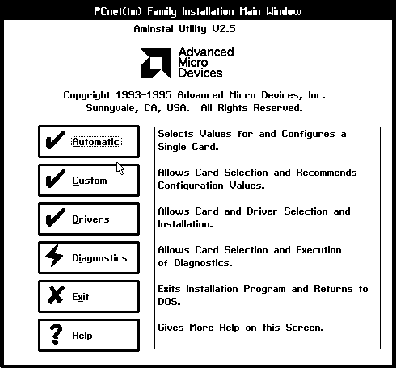
The PCnet Family Installation Main Window has the following six button selections: Automatic, Custom, Drivers, Diagnostics, Exit, and Help. Before the Main window appears, the utility searches for a PCnet adapter card in the system. If one is not found, an error screen is displayed telling the user to install the adapter card before using the utility. If only one Ethernet card is found and a conflict-free configuration is determined, the Automatic, Custom, and Drivers buttons are enabled. If more than one card is found or the configuration has conflicts, only the Custom and Drivers buttons are enabled.
The Automatic and Custom selections of the AMINSTAL utility are used to configure the PCnet adapter cards. Depending on the PCnet adapter card, the utility allows the user to view and modify the I/O Address, IRQ Level, and DMA Channel settings. The AMINSTAL utility determines settings that will configure the PCnet card to be compatible with other card settings in the system. The Automatic selection displays system compatible settings. The Custom selection displays the current PCnet card's settings and
allows the user to choose the system compatible settings.
Note: If multiple adapter cards are present, the AMINSTAL utility permits the user to select each adapter card in turn and modify its configuration settings as needed.
The Drivers selection of the AMINSTAL utility is used to install the software drivers. Depending on the operating system, the utility allows the user to select a default path or specify the destination.
The Diagnostics selection of the AMINSTAL utility is used to determine PCnet adapter card installation failures. The utility will determine: (1) if the system conflicts with the PCnet adapter card's settings and (2) if the PCnet adapter card is connected to the Local Area Network (LAN).
The Exit selection of the AMINSTAL utility quits the program.
The Help selection of the AMINSTAL utility displays screen specific information to aid in making selections. The following three help levels are always available:
| Button Help | The major screens contain a help button which displays button and field description text when selected. |
| Field-Selected (F1) Help | Displays helpful information about a selected field. |
| Dynamic Help
| Displays a one-line message at the bottom of the screen when the mouse cursor passes over the selectable item. |
After selecting "Automatic" in the PCnet Family Installation Main Window, the Automatic Card Configuration Window appears as shown in Figure 2.
The AMINSTAL utility detects and displays the following information:
Card Name DMA Channel (default) Bus Type IRQ Level (default) Ethernet Address Boot ROM Address I/O Address
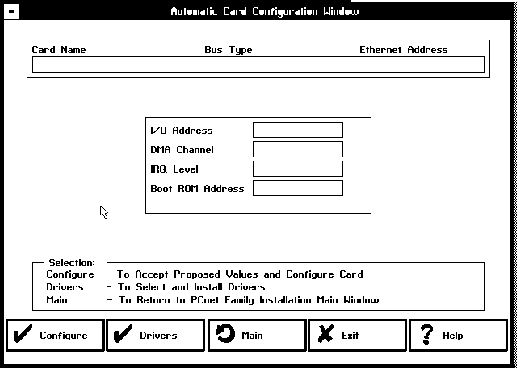 Figure 2. Automatic Card Configuration Window
Figure 2. Automatic Card Configuration Window
The Automatic Card Configuration Window has five button selections:
| Configure | To accept proposed values and configure card |
| Drivers | To select and install drivers |
| Main | To return to PCnet Family Installation Main Window |
| Exit | Exits Installation Program and returns to DOS |
| Help | Gives more help on this screen |
Refer to Section 3.2, Card Configuration, for configuring a specific PCnet adapter card.
After selecting "Custom" in the PCnet Family Installation Main Window, the Custom Card Configuration Window appears as shown in Figure 3.
The AMINSTAL utility detects and displays the following information:
Card Name I/O Address Bus Type DMA Channel (default) Ethernet Address IRQ Level (default) Card Configuration Boot ROM Address Port Mode
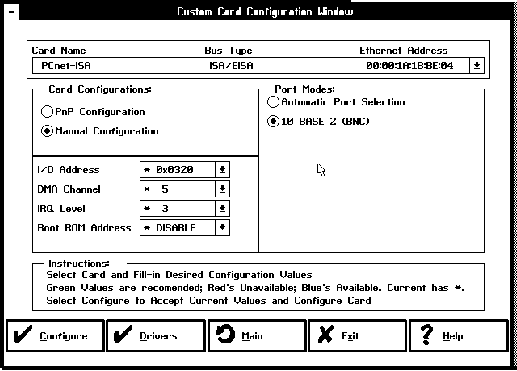 Figure 3. Custom Card Configuration Window
Figure 3. Custom Card Configuration Window
The Custom Card Configuration Window has five button selections:
| Configure | To accept current values and configure card |
| Drivers | To select and install drivers |
| Main | To return to PCnet Family Installation Main Window |
| Exit | Exits Installation Program and returns to DOS |
| Help | Gives more help on this screen |
Refer to Section 3.2, Card Configuration, for configuring
a specific PCnet adapter card.
After selecting "Drivers" in the PCnet Family Installation Main Window (or the Automatic and Custom Card Configuration Windows), the Driver Installation Window appears as shown in Figure 4. The PCnet Driver Installation Window can be used to install the following drivers:
Novell NetWare DOS ODI client driver NDIS 2.01 driver Packet driver
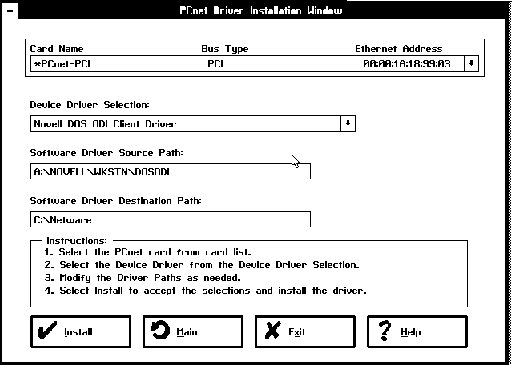 Figure 4. PCnet Driver Installation Window
Figure 4. PCnet Driver Installation Window
The PCnet Driver Installation Window has four button selections:
| Install | To accept the selections and install the driver |
| Main | To return to PCnet Family Installation Main Window |
| Exit | Exits Installation Program and returns to DOS |
| Help | Gives more help on this screen |
Refer to Section 3.3, Driver Installation, for complete instructions.
For other environments, refer to the specific driver installation
section (Section 5 through Section 11 in this manual).
After selecting "Diagnostics" in the PCnet Family Installation Main Window, the Diagnostics Window appears as shown in Figure 5. The Diagnostics Window is used to test the PCnet adapter card configuration. The AMINSTAL utility determines if the system conflicts with the card's settings and if the system can communicate with the PCnet adapter card. The test results are PASS, FAIL, and N/A (Not Applicable).
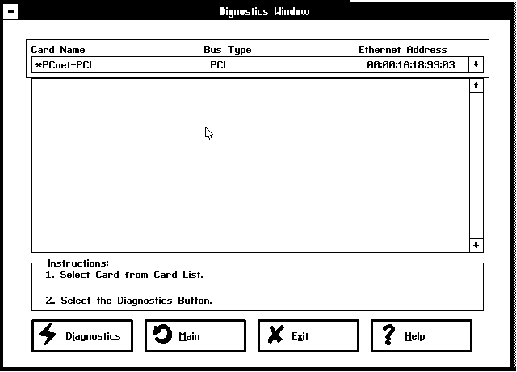 Figure 5. Diagnostics Window
Figure 5. Diagnostics Window
The I/O Address, DMA Channel, and IRQ Level are configuration
settings. A "PASS" test result means the system does not have other cards in the system set to the PCnet card's settings. A "FAIL" result means the failed setting conflicts with another card in the system. Either the PCnet adapter card's or the conflicting card's settings should be changed. Non-conflicting settings are indicated in the Automatic and Custom configuration windows as blue. A "N/A" result means the setting does not apply to the PCnet adapter card.
The loopback test indicates whether the computer system was able to communicate with the PCnet adapter card. Information is written to the adapter card and then read from it. A "PASS" test result means the system could write and read to the adapter card. A "FAIL" result means the system could not write and read to the adapter card. The loopback test is performed for all PCnet adapter cards.
The Diagnostics Window has four button selections:
| Diagnostics | To execute diagnostics test |
| Main | To return to PCnet Family Installation Main Window |
| Exit | Exits Installation Program and returns to DOS |
| Help | Gives more help on this screen |
The AMINSTAL utility detects if a PCnet-ISA adapter card is installed. If an adapter card is not already installed, refer to the PCnet-ISA Hardware User's Manual for more information on card installation.
The PCnet-ISA adapter card cannot be configured automatically.
To custom configure the PCnet -ISA adapter card, select "Custom"
in the PCnet Family Installation Main Window and skip to Section
3.2.1.2, Custom.
The "Automatic" button in the PCnet Family Installation Main Window is not activated for the PCnet-ISA adapter card.
After selecting "Custom" in the PCnet Family Installation Main Window, the Custom Card Configuration Window appears as shown in Figure 6.
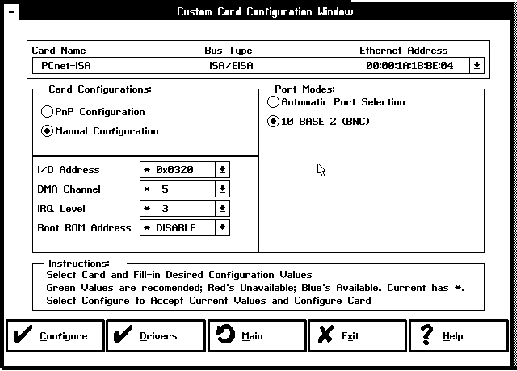 Figure 6. Custom Card Configuration Window
Figure 6. Custom Card Configuration Window
The AMINSTAL utility detects and displays the following information:
Card Name I/O Address Bus Type DMA Channel (default) Ethernet Address IRQ Level (default) Card Configuration Boot ROM Address Port Mode
The PCnet-ISA adapter card requires the user to set the appropriate jumpers on the adapter card. However, the jumper settings on the adapter card must match the Card Configuration Window settings for proper operation. Otherwise, the following warning message will be displayed:
"PCnet-ISA adapter card is not software configurable. You must set the jumpers on the PCnet-ISA adapter card."
After setting the jumpers and inserting the card, the user must enter the DMA Channel and IRQ Level in the Custom Card Configuration Window. The AMINSTAL utility will not determine the actual IRQ Level and DMA Channel settings for the adapter card, but will display the following default values:
Default DMA Channel = 5 Default IRQ Level = 3
After the necessary changes are entered, a software driver may be installed by pressing the Drivers button. Driver configuration of the I/O Address, IRQ Level, and DMA Channel may be modified. Refer to the appropriate driver installation section in this manual.
Automatic Port Selection is the default port mode. While in the Custom window, the Port Mode may be changed from "Automatic Port Selection" to "10 BASE 2 (BNC)." Automatic Port Selection allows the adapter card to automatically detect which port is connected to the network. If both ports are connected, the card will choose the 10BASE-T port. Triple-port cards may require specific port selection in the Custom Card Configuration Window. Refer to the PCnet-ISA Hardware User's Manual for more information.
Next, a software driver must be installed. Select "Configure" so that the AMINSTAL utility can specify the Configuration Options and Port Mode to the software driver as it is installed. Proceed to the appropriate driver installation section to install the software driver.
When ready to select and install a software driver, select the "Drivers" button. Refer to Section 3.1.4, PCnet Driver Installation Window, and Section 3.3, Driver Installation, for additional information.
Refer to Section 15, Installing A Universal Boot ROM, in this manual.
The AMINSTAL utility detects whether a PCnet-ISA+ (or PCnet-ISA II) adapter card is installed. If a card is not already installed, refer to the PCnet-ISA+ (or PCnet-ISA II) Hardware User's Manual for more information on card installation. The PCnet-ISA+ and PCnet-ISA II adapter cards can operate in two modes:
Microsoft Plug 'n' Play (PnP) ISA Enabled Microsoft PnP ISA Disabled
To automatically configure the PCnet-ISA (or PCnet-ISA II) adapter card, select "Automatic" in the PCnet Family Installation Main Window and follow the instructions in Section 3.2.2.1, Automatic. To custom configure the adapter card, select "Custom" in the PCnet Family Installation Main Window and skip to Section 3.2.2.2, Custom.
After selecting "Automatic" in the PCnet Family Installation Main Window, the Automatic Card Configuration Window appears as shown in Figure 7.
The AMINSTAL utility detects if a system uses PnP and sets the default parameters.
For a PnP system, the AMINSTAL utility detects and displays the following information:
PCnet-ISA+ (or PCnet-ISA II) adapter card in PnP mode Bus Type Ethernet address I/O Address DMA Channel IRQ Level
The configuration information is controlled by the PnP BIOS or a PnP configuration manager. If the PnP configuration manager is not loaded, edit the CONFIG.SYS file and reboot the system.
Boot ROM is disabled in PnP mode. To enable Boot ROM, use the Custom Card Configuration Window to disable PnP mode and manually configure the card.
PnP ISA Mode is disabled by selecting "Manual Configuration."
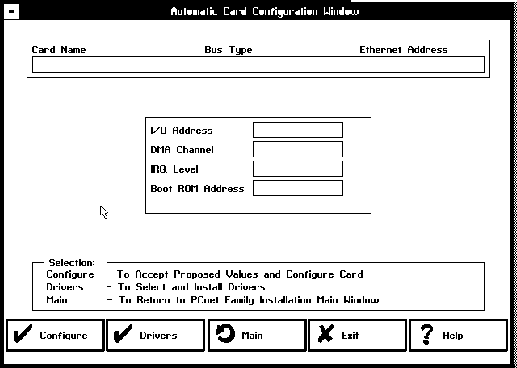 Figure 7. Automatic Card Configuration Window
Figure 7. Automatic Card Configuration Window
For a non-PnP system (one that does not respond to a PnP system call), the AMINSTAL utility detects and displays the following information:
PCnet-ISA+ (or PCnet-ISA II) adapter card in manual mode Bus Type Ethernet address I/O Address DMA Channel IRQ Level Port Mode Boot ROM
Settings are displayed in the following threecolors:
| Red | Most likely has a system conflict and may need to be changed. Use the Custom Card Configuration Window to change a red-displayed setting. |
| Blue | No system conflict |
| Green | Recommended settings |
Note: Settings with an asterisk (*) prefix are the PCnet
card's current settings.
The user should select green or blue settings for the card's configuration. Green and blue settings will not conflict with other cards' settings. Red settings conflict with other cards' settings in the system.
However, note that a PCnet card can be set to red conflicting settings and then transferred to another system. The user must ensure in advance that the red settings will not conflict in the other system.
Note: System administrators may want to take advantage of this by configuring several PCnet cards to a standard configuration in one system and then transferring them to other end-user systems for installation.
To set the configuration of the adapter card using the AMINSTAL utility, select the "Configure" button. Next, a software driver must be installed. Proceed to the specific driver installation section for the software driver being installed.
When ready to select and install a software driver, select the "Drivers" button. Refer to Section 3.1.4, PCnet Driver Installation Window, and Section 3.3, Driver Installation, for additional information.
After selecting "Custom" in the PCnet Family Installation Main Window, the Custom Card Configuration Window appears as shown in Figure 8.
The AMINSTAL utility detects if a system uses PnP and sets the default parameters. For a PnP system, the AMINSTAL utility detects and displays the following information:
PCnet-ISA+ (or PCnet-ISA II) adapter card in PnP mode Bus Type Ethernet Address I/O Address DMA Channel IRQ Level
The configuration information is controlled by the PnP BIOS or a PnP configuration manager. If the PnP configuration manager is not loaded, edit the CONFIG.SYS file and reboot the system.
Boot ROM is disabled in PnP mode. To enable Boot ROM, select "Manual Configuration" to disable PnP mode and manually configure the card.
PnP may be disabled by selecting "Manual Configuration."
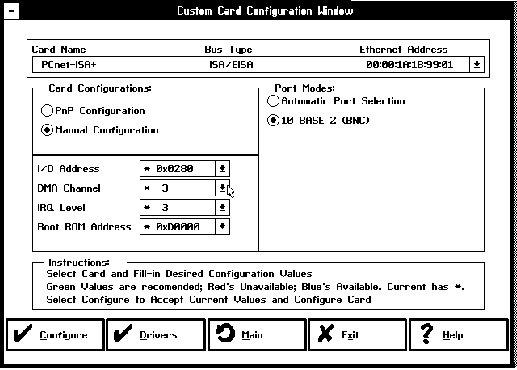 Figure 8. Custom Card Configuration Window
Figure 8. Custom Card Configuration Window
For a non-PnP system (one not responding to a PnP system call), the AMINSTAL utility detects and displays the following information:
PCnet-ISA+ (or PCnet-ISA II) adapter card in non-PnP mode Bus Type Ethernet address I/O Address DMA Channel IRQ Level Port Mode
The user may change the I/O Address, IRQ Level, and DMA Channel settings.
Settings are displayed in the following three colors:
| Red | Most likely has a system conflict and may need to be changed. Use the Custom Card Configuration Window to change a red-displayed setting. |
| Blue | No system conflict |
| Green | Recommended settings |
Note: Settings with an asterisk (*) prefix are the PCnet
card's current settings.
The user should select green or blue settings for the card's configuration. Green and blue settings will not conflict with other cards' settings. Red settings conflict with other cards' settings in the system.
However, note that a PCnet card can be set to red conflicting settings and then transferred to another system. The user must ensure in advance that the red settings will not conflict in the other system.
Note: System administrators may want to take advantage of this by configuring several PCnet cards to a standard
configuration in one system and then transferring them to other end-user systems for installation.
Automatic Port Selection is the default port mode. Any other port mode may be selected. Automatic Port Selection allows the adapter card to automatically detect which port is connected to the network. If both ports are connected, the card will choose the 10BASE-T port. Triple-port cards may require specific port selection in the Custom Card Configuration Window. See the PCnet-ISA+ (or PCnet-ISA II) Hardware User's Manual for more information.
To set the configuration of the adapter card using the AMINSTAL utility, select the "Configure" button. Next, a software driver must be installed. Proceed to the specific driver installation section for the software driver being installed.
When ready to select and install a software driver, select the "Drivers" button. Refer to Section 3.1.4, PCnet Driver Installation Window, and Section 3.3, Driver Installation, for additional information.
Refer to Section 15, Installing A Universal Boot ROM, in this manual.
The AMINSTAL utility detects if a PCnet-32 adapter card is installed. If a card is not already installed, refer to the PCnet-32 Hardware User's Manual for more information on card installation.
To automatically configure the PCnet-32 adapter card, select "Automatic" in the PCnet Family Installation Main Window and follow the instructions in Section 3.2.3.1, Automatic. To custom configure the adapter card, select "Custom" in the PCnet Family Installation Main Window and skip to Section 3.2.3.2, Custom.
After selecting "Automatic" in the PCnet Family Installation Main Window, the Automatic Card Configuration Window appears as shown in Figure 2.
VL bus systems are not PnP compatible. Hence, configuration options are limited to "Manual Configuration." The AMINSTAL utility detects and displays the following information:
PCnet-32 adapter card Bus Type Ethernet address I/O Address DMA Channel IRQ Level
The DMA Channel setting is DISABLED since the VL bus designates the DMA Channel according to each slot. Settings are displayed in the following three colors:
| Red | Most likely has a system conflict and may need to be changed. Use the Custom Card Configuration Window to change a red-displayed setting. |
| Blue | No system conflict |
| Green | Recommended settings |
Note: Settings with an asterisk (*) prefix are the PCnet
card's current settings.
To set the configuration of the adapter card using the AMINSTAL utility, select the "Configure" button. Next, a software driver must be installed. Proceed to the appropriate driver installation section for the software driver being installed.
When ready to select and install a software driver, select the "Drivers" button. Refer to Section 3.1.4, PCnet Driver Installation Window, and Section 3.3, Driver Installation, for additional information.
After selecting "Custom" in the PCnet Family Installation Main Window, the Custom Card Configuration Window appears as shown in Figure 3.
VL bus systems are not PnP compatible. Hence, configuration options are limited to "Manual Configuration." The AMINSTAL utility detects and displays the following information:
PCnet-32 adapter card Bus Type Ethernet address I/O Address DMA Channel IRQ Level Port Mode
The DMA Channel setting is DISABLED since the VL bus designates the DMA Channel according to each slot. The I/O Address and IRQ Level may be changed. Settings are displayed in the following three colors:
| Red | Most likely has a system conflict and may need to be changed. Use the Custom Card Configuration Window to change a red-displayed setting. |
| Blue | No system conflict |
| Green | Recommended settings |
Note: Settings with an asterisk (*) prefix are the card's
current settings.
The user should select green or blue settings for the card's configuration. Green and blue settings will not conflict with other cards' settings. The user must be careful not to select red settings. Red settings
conflict with other card' settings in the system. However, note that a PCnet card can be set to red conflicting settings and then transferred to another system. The user must ensure in advance that the red settings will not conflict in the other system.
Note: System administrators may want to take advantage of this by configuring several PCnet cards to a standard
configuration in one system and then transferring them to other end-user systems for installation.
Automatic Port Selection is the default port mode. Any other available port mode may be selected. Automatic Port Selection allows the adapter card to automatically detect which port is connected to the network. If both ports are connected, the card will choose the 10BASE-T port. Triple-port cards may require specific port selection in the Custom Card Configuration Window. See the PCnet-32 Hardware User's Manual for more information.
To set the configuration of the adapter card using the AMINSTAL utility, select the "Configure" button. Next, a software driver must be installed. Proceed to the appropriate driver installation section for the software driver being installed.
When ready to select and install a software driver, select the "Drivers" button. Refer to Section 3.1.4, PCnet Driver Installation Window, and Section 3.3, Driver Installation, for additional information.
The AMINSTAL utility detects if a PCnet-PCI adapter card is installed. If a card is not already installed, refer to the PCnet-PCI Hardware User's Manual for more information on card installation.
To automatically configure the PCnet-PCI adapter card, select "Automatic" in the PCnet Family Installation Main Window and follow the instructions in Section 3.2.4.1, Automatic. To custom configure the adapter card, select "Custom" in the PCnet Family Installation Main Window and skip to Section 3.2.4.2, Custom.
After selecting "Automatic" in the PCnet Family Installation Main Window, the Automatic Card Configuration Window appears as shown in Figure 2. The AMINSTAL utility detects and displays the following information:
PCnet-PCI adapter card Bus Type Ethernet address I/O Address DMA Channel IRQ Level
The I/O Address, IRQ Level, and DMA Channel are assigned by the PCI system BIOS. The DMA Channel in the PCI bus is slot specific and is not associated to a number. The user may not modify the configuration options for the PCnet-PCI adapter card.
To set the configuration of the adapter card using the AMINSTAL utility, select the "Configure" button. Next, a software driver must be installed. Proceed to the appropriate driver installation section for the software driver being installed.
When ready to select and install a software driver, select the "Drivers" button. Refer to Section 3.1.4, PCnet Driver Installation Window, and Section 3.3, Driver Installation, for additional information.
After selecting "Custom" in the PCnet Family Installation Main Window, the Custom Card Configuration Window appears as shown in Figure 3.
The AMINSTAL utility detects and displays the following information:
PCnet-PCI adapter card Bus Type Ethernet address I/O Address DMA Channel IRQ Level Port Mode
The I/O Address, IRQ Level, and DMA Channel are assigned by the PCI system BIOS. The DMA Channel in the PCI bus is slot specific and is not associated to a number. The user cannot modify the configuration options for the PCnet-PCI adapter card.
Automatic Port Selection is the default port mode. Any other port mode may be selected. Automatic Port Selection allows the adapter card to automatically detect which port is connected to the network. If both ports are connected, the card will choose the 10BASE-T port. Triple-port cards may require specific port selection in the Custom Card Configuration Window. Refer to the PCnet-PCI Hardware User's Manual for more information.
To set the configuration of the adapter card using the AMINSTAL utility, select the "Configure" button. Next, a software driver must be installed. Proceed to the appropriate driver installation section for the software driver being installed.
When ready to select and install a software driver, select the "Drivers" button. Refer to Section 3.1.4, PCnet Driver Installation Window, and Section 3.3, Driver Installation, for additional information.
The PCnet Driver Installation Window of the AMINSTAL utility can be used to install the following drivers:
Novell NetWare DOS ODI client driver (see Section 5) NDIS 2.01 driver (see Section 6) Packet driver (see Section 13)
For other environments, refer to the appropriate driver installation section in this manual for instructions.
Select "Drivers" in the PCnet Family Installation Main Window (also in the Automatic Card Configuration Window or Custom Card Configuration Window). The PCnet Driver Installation Window will appear as shown in Figure 4. A driver may be installed by selecting the driver and specifying the destination directory. Select "Install" to copy the driver to the system hard drive.
Notes:1) When the AMINSTAL utility installs a device driver, it creates sample CONFIG.NET, AUTOEXEC.NET, and PROTOCOL.INI or NET.CFG files. The user may use these files as examples to modify the system's CONFIG.SYS and AUTOEXEC.BAT files.
2) See Installing The NDIS 2.01 Driver section (Microsoft LAN Manager) for more information on the PROTOCOL.INI file. See Appendix A for more information on the NET.CFG file.
Some drivers must be installed using the Network Operating System's OEM installation guidelines. Refer to Section 4, Automatic OEM Installation, for more information.
The AMINSTAL utility can be customized by OEMs in the following ways:
1. The PCnet Family Installation Main Window must be customized by replacing the AMD-specific graphics and text with OEM-specific graphics and text.
2. The FFFF card place holder must be changed to the manufacturer's IEEE address prefix.
3. The button labels, window titles, data labels, screen text, and help messages of each section are customizable and can be in any language.
The pcnet.txt file specifies AMINSTAL's characteristics. By changing keywords and text strings in pcnet.txt, the utility can be customized without editing and recompiling the program. The pcnet.txt file is located in the a:\aminstal directory on the "All Drivers" disk. It is important to test run the AMINSTAL utility after each text string modification to identify editing mistakes, such as deleted or extra quotes and missing text, which will prevent the program from running.
Refer to Appendix E, PCnet Family AMINSTAL Utility OEM Customization Guide, for further customization details.